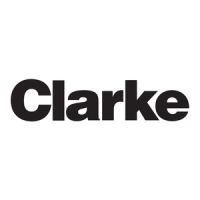44
9. Maintenance Schedule
NOTE: The following Routine Maintenance schedule is based on an engine usage rate not exceeding 2 hours
per month. For UL/FM engine models, also refer to NFPA25.
The Maintenance Schedule Checklist is an optional document to record Clarke Fire specific maintenance items.
Based on NFPA 25 and Clarke Fire maintenance requirements, document C137684 was created for customer
and technician record keeping purposes. The PDF can be downloaded from ClarkeFire.com
Weekly Maintenance Items
Check the Air Filter for rips, crushed elements or extreme dirt. A dirty filter can make it more difficult for the
engine to draw in air and effect the power output.
Check the Battery electrolyte level and cable connections.
Check the Coolant Hoses for rips, splitting, collapses or bulges.
The heater system typically contains two to four hoses.
The heat exchanger assembly typically contains three to six hoses.
Check the Coolant Level.
Check the Fuel Tank. Inspect the outside of the container for signs of deterioration or leaks. This visual
inspection is intended to be a routine walk-around and includes the tank’s piped connections, supports and
foundations.
Check the Jacket Water Heater. The heater should be warm to the touch. Confirm there is no discoloration to
the outside of the heater assembly. Discoloration could indicate an overheating heater assembly.
Check the Lubrication Oil Level. The level must always be between the dipstick marks Min. and Max. with the
engine not running.
Remove water from the fuel filter by opening the valve under the filter and let water and sediment flow until fuel
comes out.
Check the Not In Auto Warning Light. Ensure the warning bulb is functional by changing the mode selector
switch to the manual mode position.
Check the Manual Valves on the cooling loop. The bypass line manual valves should be normally closed, and
the automatic line manual valves should be normally open.
Check and Clean the Y-strainer screens. With the engine off, close the manual valves to restrict flow to the
cooling loop. Remove the endcaps on the y-strainer assembly and pull the screens. Clean the screens and
ensure there is no containments or restrictions inside the y-strainer. Replace the screens, install the endcaps and
return the manual valves to the normal position.
Run the engine.
Starting Method: From the Fire Pump Controller using test feature or actual pressure drop.
With the engine instrument panel in the automatic mode, start the engine from the pump controller using a test
feature or pressure drop.
The engine is designed to operate at rated load conditions. For testing purposes, the engine can run at
lower load (lower flow) conditions. Running times in any one period should not exceed 30 minutes maximum.
When the engine is running make sure that the coolant temperature, oil pressure and raw water flow
are within limits specified on the relevant Installation & Operation Data Sheet.
Check the Operating Gauges on the engine instrument panel.
Check the Cooling Loop Raw Water Solenoid for operation while the engine is running.
Check the Heat Exchanger Discharge for free flow of water.
Check the Exhaust System for leaks, proper support and operational rain cap.
General Inspection for excessive noise, adequate ventilation, missing items, fluid leaks or anything broken.
6 Month Maintenance Items
Clean the Battery posts and cable connectors. Use baking soda and water or battery cleaner to clean the
terminals and battery surfaces. Use terminal spray or Vaseline on the terminals to minimize corrosion.
Check the Battery Charging Alternator for proper operation.
Disable the pump controller battery chargers.
Read the battery voltage with the engine off. (ex: 12 or 24 vdc)
Read the battery voltage with the engine running. (ex: 14-15 or 27-29 vdc)
Compare the readings to determine if the alternator is charging.
Enable the pump controller battery chargers
Check the Belt for proper tension, alignment, signs of fraying or cracks.

